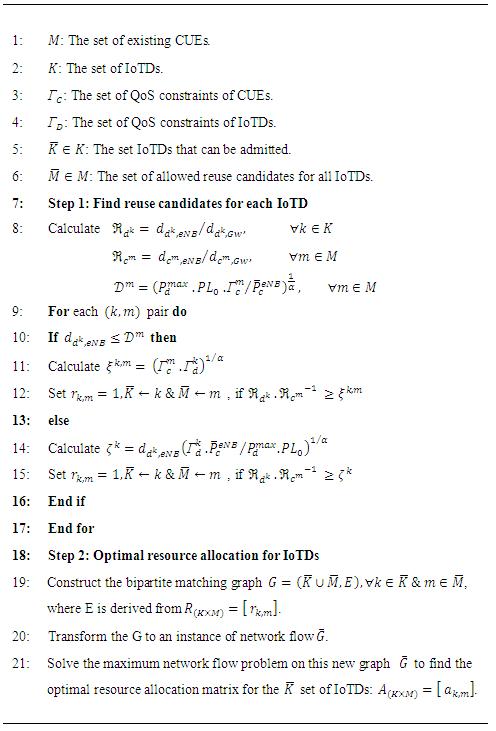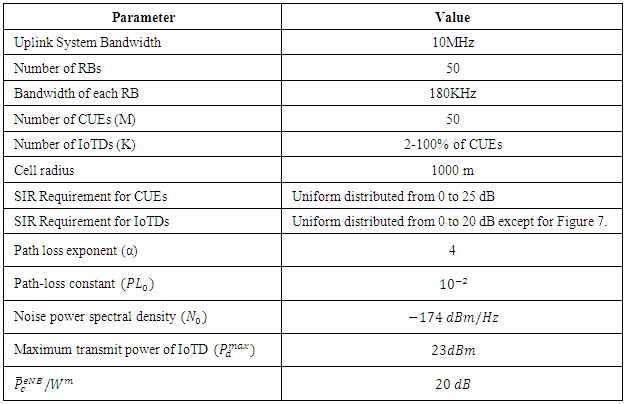-
Paper Information
- Paper Submission
-
Journal Information
- About This Journal
- Editorial Board
- Current Issue
- Archive
- Author Guidelines
- Contact Us
Journal of Wireless Networking and Communications
p-ISSN: 2167-7328 e-ISSN: 2167-7336
2016; 6(1): 1-9
doi:10.5923/j.jwnc.20160601.01

D2D Communications for Enabling Internet of Things Underlaying LTE Cellular Networks
Mahmoud M. Elmesalawy
Department of Electronics, Communications, and Computers Engineering, Helwan University, Cairo, Egypt
Correspondence to: Mahmoud M. Elmesalawy, Department of Electronics, Communications, and Computers Engineering, Helwan University, Cairo, Egypt.
| Email: |  |
Copyright © 2016 Scientific & Academic Publishing. All Rights Reserved.
This work is licensed under the Creative Commons Attribution International License (CC BY).
http://creativecommons.org/licenses/by/4.0/

Internet of Things (IoT) is an emerging paradigm that provides the future network of interconnected devices. On the other hand, Device-to-Device (D2D) communication is considered a promising technology that providing a mechanism for sharing the radio resources of LTE eNodeB for efficient spectrum utilization. A novel method is introduced in this paper to provide the required connectivity between a group of IoT devices (IoTDs) and its associated IoT gateway (IoT-GW) using D2D communication underlaying LTE networks. In this context, a quality of service (QoS) based resource allocation scheme for IoTDs is proposed for enabling IoT services underlaying LTE networks. The proposed scheme is based on two main steps. In the first step, the set of allowed cellular user equipment (CUE) reuse candidates for each IoTD is determined taking into consideration the QoS requirements for both of CUEs and IoTDs. In the second step, the optimal resource allocation for each IoTD is determined. The optimization problem is modeled as a maximum bipartite matching problem that finds the optimal CUE reuse candidate for each IoTD with the objective to maximize the total number of IoTDs that can be admitted. Simulation results showed that the proposed method can be used to provides an efficient D2D-based IoT connectivity underlaying LTE cellular networks with outstanding performance in terms of access rate and achieved network throughput gain.
Keywords: Internet of Things, LTE, D2D Communication, Resource Allocation, and Bipartite Maximum Matching
Cite this paper: Mahmoud M. Elmesalawy, D2D Communications for Enabling Internet of Things Underlaying LTE Cellular Networks, Journal of Wireless Networking and Communications, Vol. 6 No. 1, 2016, pp. 1-9. doi: 10.5923/j.jwnc.20160601.01.
Article Outline
1. Introduction
- The remarkable evolution and convergence of cellular and IP networks provide the ultimate communication infrastructure for internet of things (IoT). IoT next-generation devices are expected to be deployed rapidly in residential and industrial environments, thus direct interoperability with already existing cellular networks will be an essential requirement. Several applications are envisioned for IoT over cellular networks. This includes smart meters, vending machines, remote sensors, consumer devices, and vehicular applications. The IoT is expected to be the next big issue in the mobile ecosystem with IoT services being a key driver for further growth in next generation mobile systems [1].The all-IP based architecture of LTE and LTE-A cellular networks makes it ideal for IoT applications. In LTE, the Physical Resource Block (PRB) represents the smallest radio resource unit that can be allocated to the end device as standardized by the 3GPP [2]. Since in most of IoT applications, the devices are usually transmit small amount of data at a given particular time [3]. Therefore allocation of an entire PRB to a single device will lead to degradation in the spectral efficiency. Moreover, as many types of devices in IoT environment have limited resources in terms of power and computational capability; therefore, an energy efficient communication technology is crucial for such types of devices. All of the aforementioned requirements can be achieved by using a gateway for collecting the data from a group of IoT devices (IoTDs) and then resending it to the LTE eNodeB. Using gateway will allow different devices to share a single PRB at the same time and thus increase the spectral efficiency. Furthermore, the energy consumption by each device for the communication purpose is reduced due to the short distance between the devices and gateway.Several short-range wireless communication technologies such as Bluetooth, Zigebee, and WiFi are already used for providing communication between IoTDs and the IoT gateway (IoT-GW). Since the data transmission in these technologies occurs over an unlicensed spectrum, interference avoidance will be a challenge [4]. On the other hand, communications on a licensed band of a cellular network can provide better performance in terms of interference avoidance due to the controlled environment. Device-to-Device (D2D) communication has become a promising technology for short range communication underlying LTE cellular networks. D2D communication has been proposed for cellular networks to improve the spectral efficiency and thereby increase network capacity [5-7]. The idea is based on allowing the proximity devices to establish a direct connectivity to exchange its data under the control of eNodeB.Three operation modes have been defined for devices in LTE networks supported D2D communication. These modes are reuse mode, dedicated mode, and cellular mode [8]. In reuse mode, the radio resources allocated to cellular users are allowed to be reused by D2D devices. In the dedicated mode, a part of the available radio resources is reserved and dedicated for D2D communications, whereas the cellular mode allows the traditional way of transmitting data through eNodeB. Dedicated and cellular operation modes require very simple and straightforward interference management schemes; however, they do not provide efficient utilization of the available radio resources. Although the reuse mode improves the spectral efficiency of the system, interference between D2D and cellular communications may be introduced. However, this interference can be managed as the entire network is still controlled by a cellular network infrastructure. Extensive research works for the interference management in case of reuse operation mode are provided in [7], [9-17]. It is also important to mention that the reuse mode minimizes energy consumption as most of the procedures that used for establishing of D2D communication are carried out by eNodeB [18], [19].In LTE-IoT environment, there are many devices will compete to access the available radio resources in order to transmit their data. Therefore, using D2D communication technology in a reuse mode to provide the communication between a group of IoTDs and its associated IoT-GW is especially imperative. It is proved that enabling the D2D communication with reuse mode can provide a higher sum rate compared with the pure cellular communications [20]. Using D2D communication underaying LTE for providing the communication between IoTDs and its IoT-GW will lead to several benefits compared to other existing short-range communication technologies such as Bluetooth, WiFi, or Zigbee. This includes: a) automated secure authentication during the connection establishment since IoTDs would have been registered and controlled by LTE network. b) Automatic pairing between IoTDs and IoT-GW which controlled by eNodeB. c) D2D communication can support longer communication distances and higher data rates compared to the other mentioned technologies [21]. Finally, efficient interference mitigation can be achieved due to the coordinated short range communication over licensed band.In this paper, D2D communication technology is introduced to provide the required connectivity between a set of IoTDs and its associated IoT-GW underlaying LTE networks. An uplink resource allocation scheme with QoS provisioning is proposed for supporting IoT services underlaying LTE networks. The proposed scheme is based on two main steps. The first step is proposed to determine the set of permitted CUEs reuse candidates for each IoTD. In the second step, an optimal resource allocation for each IoTD is determined with the objective to maximize the total number of IoTDs that can be admitted.The rest of this paper is organized as follows. Section 2, introduces the system model and problem formulation. In section 3, the proposed resource allocation scheme for IoTDs is presented. The performance analysis and discussion is provided in section 4. Finally, the paper is concluded in section 5.
2. System Model and Problem Formulation
- In this section, the system model is first introduced and then the resource allocation problem for IoTDs is formulated.
2.1. System Model
- The proposed system model for supporting IoT using D2D communications underlaying LTE networks is introduced in this subsection. The model is based on reusing the uplink radio resources of LTE network for providing the communication between each group of IoT devices and its associated IoT gateway. A cell including a number of cellular users and one IoT gateway serving a group of IoT devices is considered. Each IoTD in the group will send its data to the IoT-GW by sharing the uplink resources allocated for cellular users in the cell. The IoT gateway acts as a data concentrator which collects the data from all IoTDs in his group and re-sends it to the eNodeB using the available uplink radio resources. Let
 represents the group of cellular users in the cell and
represents the group of cellular users in the cell and  represents the set of IoTDs that require to exploits the same uplink radio resources of the M-CUEs. In LTE, the system bandwidth is divided into equal size resource blocks (RBs). In our model, each CUE is assumed to be allocated one separate RB in the uplink period with no interference exists among CUEs. All IoTDs have the same destination which is the IoT-GW. In order to avoid interference between IoTDs transmissions at the receiver of the IoT-GW, the resource allocation process should be managed in such a way to avoid reusing of same radio resources by more than one IoTD simultaneously.The transmit power of CUEs, denoted by
represents the set of IoTDs that require to exploits the same uplink radio resources of the M-CUEs. In LTE, the system bandwidth is divided into equal size resource blocks (RBs). In our model, each CUE is assumed to be allocated one separate RB in the uplink period with no interference exists among CUEs. All IoTDs have the same destination which is the IoT-GW. In order to avoid interference between IoTDs transmissions at the receiver of the IoT-GW, the resource allocation process should be managed in such a way to avoid reusing of same radio resources by more than one IoTD simultaneously.The transmit power of CUEs, denoted by  are controlled to make the average received powers from all CUEs have the same power level at the eNodeB [22]. Each IoTD transmits its data to IoT-GW on a reused radio resources of a particular
are controlled to make the average received powers from all CUEs have the same power level at the eNodeB [22]. Each IoTD transmits its data to IoT-GW on a reused radio resources of a particular  with a transmit power level denoted by
with a transmit power level denoted by  and constrained by the IoTD maximum transmit power which represented by
and constrained by the IoTD maximum transmit power which represented by  .A distanced based path-loss model defined as
.A distanced based path-loss model defined as  is used, where
is used, where  and
and  refer to the initial transmit power and the signal power measured at
refer to the initial transmit power and the signal power measured at  away from the transmitter respectively;
away from the transmitter respectively;  and
and  are the path-loss constant and path-loss exponent respectively [23]. We define
are the path-loss constant and path-loss exponent respectively [23]. We define  and
and  as the set of minimum signal-to-interference ratio (SIR) that must be attained to meet the QoS requirements of CUEs and IoTDs respectively. We assumed that the cellular users are uniformly distributed in the cell and they are controlled by the eNodeB. Figure 1 shows the system model for supporting Internet of things using D2D communication underlaying LTE network. In this figure, black and green lines represent the transmission links for CUEs and IoTDs respectively. On the other hand, red links represent the interference from both IoTDs on eNodeB and from CUEs on IoT-GW receiver due to resource sharing.
as the set of minimum signal-to-interference ratio (SIR) that must be attained to meet the QoS requirements of CUEs and IoTDs respectively. We assumed that the cellular users are uniformly distributed in the cell and they are controlled by the eNodeB. Figure 1 shows the system model for supporting Internet of things using D2D communication underlaying LTE network. In this figure, black and green lines represent the transmission links for CUEs and IoTDs respectively. On the other hand, red links represent the interference from both IoTDs on eNodeB and from CUEs on IoT-GW receiver due to resource sharing.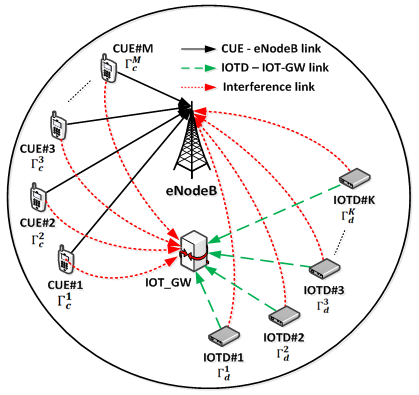 | Figure 1. System model of communications between IoTDs and IoT-GW |
2.2. Problem Formulation
- Any IoTD can communicate with the IoT-GW by reusing the same radio resources of a particular CUE only when the QoS constraints in terms of SIR for both, IoTD and CUE can be guaranteed. In such case, we call this device as an admissible IoTD and the CUE which its resources is shared is called a reuse candidate. Let us define matrix
 as the allowed reusing matrix which indicates the set of allowed reuse candidates for each IoTD#k that satisfies the required QoS constraints. If
as the allowed reusing matrix which indicates the set of allowed reuse candidates for each IoTD#k that satisfies the required QoS constraints. If  is a reuse candidate for
is a reuse candidate for  then
then  ; otherwise,
; otherwise,  . Since each CUE can allowed to be a reuse candidate for more than one IoTD, optimal allocation of resources for IoTDs is required. Let us define matrix
. Since each CUE can allowed to be a reuse candidate for more than one IoTD, optimal allocation of resources for IoTDs is required. Let us define matrix  as the resource allocation matrix as,
as the resource allocation matrix as, | (1) |
 | (2) |
 | (2a) |
 | (2b) |
 and can be calculated as follows,
and can be calculated as follows, | (3) |
3. Optimal Resource Allocation for IoTDs
- The proposed resource allocation technique is based on two main steps. The first step is to determine the different reuse candidates for each IoTD under the QoS constrains for both CUEs and IoTDs. In the second step, the optimal resource allocation for each IoTD is determined based on the resulted reuse candidates for each IoTD with the objective to maximize the total number of IoTDs that can be admitted. The following subsections present the mentioned two steps in details.
3.1. Interference Coordination and IoTDs Reuse Candidates
- Two types of interference can be introduced in the proposed system as a result of sharing the uplink radio resources of CUEs by IoTDs. The first type is the interference introduced on the received signals of CUEs at eNodeB due to the IoTDs transmissions. The second type is the interference introduced on the received signals of IoTDs at the IoT-GW as a result of CUEs transmissions. These two types of interferences should be managed carefully in order to guarantee the required QoS constraints for both CUEs and IoTDs. It is also important to note that the radio resources of a particular CUE is not allowed to be reused by more than one IoTD. This will ensure that there is no interference introduced between the transmissions of different IoTDs at the receiver of IoT-GW. Since the cellular communication is the primary service in the cell, the maximum transmit power of IoTDs is strictly limited to avoid any harmful interference on the received signals of CUEs at eNodeB. Let us assume that the average received powers from all CUEs at eNodeB are controlled to the same power level that is denoted by
 . Therefore, based on the presented distanced path-loss model, the transmit power by
. Therefore, based on the presented distanced path-loss model, the transmit power by  can be expressed as,
can be expressed as, | (4) |
 is the link distance between
is the link distance between  and eNodeB while
and eNodeB while  is the path-loss exponent of that link. We assume that each IoTD exploiting the same uplink radio resources of one CUE. Therefore to avoid any harmful interference from IoTDs to CUEs and guarantee the required QoS constraint for each CUE, the SIR condition in (5) must be satisfied.
is the path-loss exponent of that link. We assume that each IoTD exploiting the same uplink radio resources of one CUE. Therefore to avoid any harmful interference from IoTDs to CUEs and guarantee the required QoS constraint for each CUE, the SIR condition in (5) must be satisfied. | (5) |
 represents the interference power received at eNodeB from
represents the interference power received at eNodeB from  that exploiting the same uplink radio resources of
that exploiting the same uplink radio resources of  . Given
. Given  as the link distance between
as the link distance between  and the eNodeB,
and the eNodeB,  can be expressed as
can be expressed as | (6) |
 is the transmit power of
is the transmit power of  using the same radio resources allocated to
using the same radio resources allocated to  . Using (5) and (6), the constraint on the transmit power of any
. Using (5) and (6), the constraint on the transmit power of any  reusing the same uplink radio resources of
reusing the same uplink radio resources of  can be derived as in (7) in order to guarantee the required QoS constraint for CUEs.
can be derived as in (7) in order to guarantee the required QoS constraint for CUEs. | (7) |
 is limited by
is limited by  , constraint (7) can be rewritten as follows,
, constraint (7) can be rewritten as follows, | (8) |
 as follows,
as follows,  | (9) |
 . On the other hand, to ensure the performance of IoTDs communication and avoid any harmful interference at the receiver of the IoT-GW, the required QoS constraint in terms of SIR for each IoTD should be maintained. This can be formulated as follows,
. On the other hand, to ensure the performance of IoTDs communication and avoid any harmful interference at the receiver of the IoT-GW, the required QoS constraint in terms of SIR for each IoTD should be maintained. This can be formulated as follows, | (10) |
 is the link distance between
is the link distance between  and the IoT-GW, while
and the IoT-GW, while  represents the received interference power at IoT-GW on the transmission of IoTD#k that exploiting the same uplink radio resources of
represents the received interference power at IoT-GW on the transmission of IoTD#k that exploiting the same uplink radio resources of  . Given
. Given  as the link distance between
as the link distance between  and the IoT-GW; then
and the IoT-GW; then  can be expressed as follows,
can be expressed as follows, | (11) |
 | (12) |
 that reusing the same radio resources of
that reusing the same radio resources of  can be determined according to the following condition,
can be determined according to the following condition, | (13) |
 In this case,
In this case,  can be considered as a reuse candidate for IoTD#k if the following condition is achieved,
can be considered as a reuse candidate for IoTD#k if the following condition is achieved, | (14) |
 and
and  represent the distance ratios of
represent the distance ratios of  and
and  to eNodeB and IoT-GW respectively. Therefore equation (14) can be rewritten as follows,
to eNodeB and IoT-GW respectively. Therefore equation (14) can be rewritten as follows, | (15) |
 . The distance ratios
. The distance ratios  and
and  can be calculated in terms of the locations of IoT-GW, IoTDs, and CUEs within the cell as shown in (16)
can be calculated in terms of the locations of IoT-GW, IoTDs, and CUEs within the cell as shown in (16) | (16a) |
 | (16b) |
 and
and  denotes the coordinate positions of IoT-GW, IoTDs, and CUEs within the cell respectively.
denotes the coordinate positions of IoT-GW, IoTDs, and CUEs within the cell respectively. In this case,
In this case,  can be considered as a reuse candidate for IoTD#k if the following condition is achieved,
can be considered as a reuse candidate for IoTD#k if the following condition is achieved, | (17) |
 and
and  as follows,
as follows, | (18) |
 It is important to note that in this case, the distance between IoTD and eNodeB is far enough to allow the IoTD#k to transmit with its maximum allowable power
It is important to note that in this case, the distance between IoTD and eNodeB is far enough to allow the IoTD#k to transmit with its maximum allowable power  while maintaining the required QoS for
while maintaining the required QoS for  .
. | (19) |
3.2. Maximum Bipartite Matching
- In the previous subsection, we have discussed how to find the different reuse candidates for each IoTD with targeted QoS requirements for both IoTDs and CUEs. In this subsection, the optimal reuse partner for each IoTD when more than one partner CUEs are available is determined. As the main objective of the proposed technique is to maximize the total number of admitted IoTDs, the optimal resource allocation problem is modeled as a maximum bipartite matching problem. In order to reduce the computational complexity, the IoTDs that resulted with no reuse candidates according to condition (19) are removed from the set of IoTDs while constructing the bipartite graph. Therefore, the bipartite graph is constructed using only the set of IoTDs that can be admitted
 and the union of its all reuse candidates from CUEs
and the union of its all reuse candidates from CUEs  . Figure 2 shows the maximum bipartite matching graph, where
. Figure 2 shows the maximum bipartite matching graph, where  and
and  are assumed as the two groups of vertices in the bipartite graph. Vertex
are assumed as the two groups of vertices in the bipartite graph. Vertex  is joined with vertex
is joined with vertex  by an edge
by an edge  , when
, when  is a reuse candidate of IoTD#k.
is a reuse candidate of IoTD#k. | Figure 2. Bipartite graph for IoTDs and the reuse candidates matching problem |
 ; find
; find  that is a matching and is as large as possible. One way to solve this matching problem is to reduce it to an instance of maximum flow. Then, the solution to the network flow problem can easily be used to find the solution to the maximum bipartite matching. Figure 3 shows the reduced bipartite matching graph to the network flow.
that is a matching and is as large as possible. One way to solve this matching problem is to reduce it to an instance of maximum flow. Then, the solution to the network flow problem can easily be used to find the solution to the maximum bipartite matching. Figure 3 shows the reduced bipartite matching graph to the network flow.  | Figure 3. Reduced Bipartite matching graph to network flow |
 and
and  vertices a capacity of 1 that makes a flow of 1 between
vertices a capacity of 1 that makes a flow of 1 between  and its reuse candidate
and its reuse candidate  will correspond to matching
will correspond to matching  to reuse the radio resources of
to reuse the radio resources of  . Finally, find the maximum flow from s to t. The amount of flow we can push is exactly the number of original edges that will be used to connect an IoTD to a reuse candidate. Furthermore, no IoTD or reuse candidate vertex will be used more than once. Thus, the solution of the optimal resource allocation problem for IoTDs with targeted QoS requirements can be derived and illustrated by algorithm 1.
. Finally, find the maximum flow from s to t. The amount of flow we can push is exactly the number of original edges that will be used to connect an IoTD to a reuse candidate. Furthermore, no IoTD or reuse candidate vertex will be used more than once. Thus, the solution of the optimal resource allocation problem for IoTDs with targeted QoS requirements can be derived and illustrated by algorithm 1.
|
4. Performance Analysis and Discussion
- In this section, the performance of the proposed resource allocation technique is evaluated using simulation results. First, the performance metrics used in the evaluation process are defined. Then the proposed technique is evaluated in terms of the defined metrics at various system parameters. Two metrics are used to evaluate the performance of the proposed technique. The first one is the access rate which is defined as the ratio of the number of worked IoTDs in the D2D reuse operation mode to the total number of IoTDs existed in the system. The second one is the throughput gain which is defined as the increase in the overall network throughput due to sharing of the CUEs uplink resources by IoTDs. The throughput gain can be computed as follows,
 | (20) |
|
 . Finally, the IoTDs are uniformly distributed around the IoT-GW according to the maximum defined distance between IoTDs and
. Finally, the IoTDs are uniformly distributed around the IoT-GW according to the maximum defined distance between IoTDs and  .
.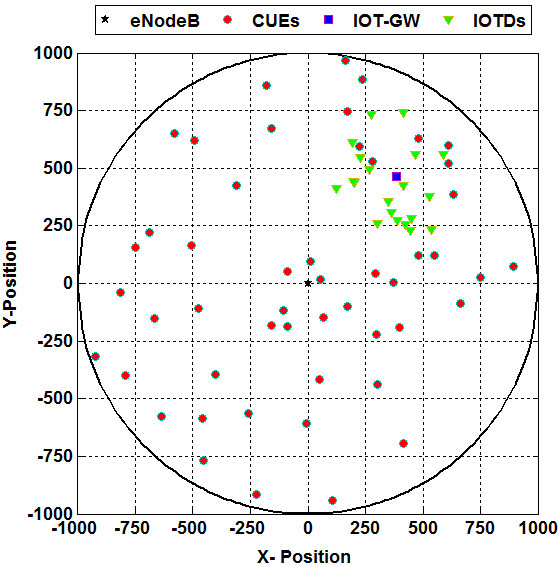 | Figure 4. Snapshot for CUEs, IoTDs, and IoT-GW distribution in LTE cell when  |
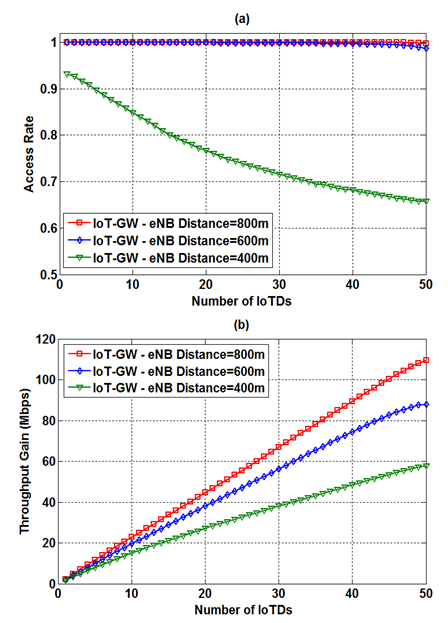 | Figure 5. Access rate and throughput gain vs. the number of IoTDs when  |
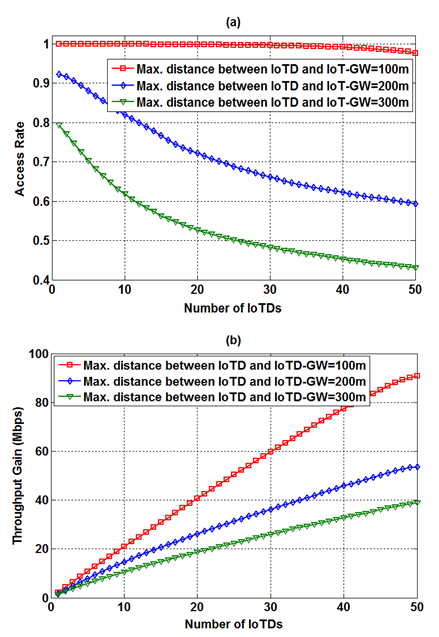 | Figure 6. Access rate and throughput gain vs. the number of IoTDs when  |
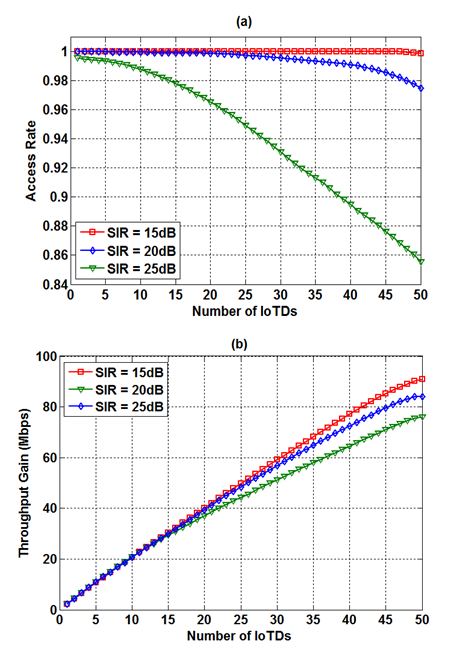 | Figure 7. Access rate and throughput gain vs. the number of IoTDs when  |
5. Conclusions and Future Work
- In this paper, a new method is proposed to enable IoT services underlaying LTE cellular networks by using D2D communication technology. The proposed method is based on reusing the uplink radio resources allocated for cellular users in LTE networks to provide the required connectivity between a group of IoTDs and its associated IoT gateway. In order to manage the interference between CUEs and IoTDs, and attaining the required QoS constrains for both of them; two steps based uplink resource allocation scheme for IoTDs with QoS provisioning is proposed. In the first step, the set of allowed cellular user equipment (CUE) reuse candidates for each IoTD is determined. In this step, the interference between CUEs and IoTDs is considered and coordinated in order to assure the required QoS constraints for both of CUEs and IoTDs. In the second step, the optimal resource allocation problem is modeled as a maximum bipartite matching problem to determine the optimal reuse partner for each IoTD with the objective to maximize the total number of IoTDs that can be admitted. Simulation results showed that the proposed method can be used to provide IoTDs communications underlaying LTE networks with effective performance in terms of access rate and achieved network throughput gain. Moreover, the advantages of coordinated interference and embedded automatic pairing and security services of the proposed method make it a promising solution compared to other short-range communication technologies for IoTDs transmissions. In future research, the resource allocation problem in case of each IoTD share the resources with multiple CUEs will be considered.
 Abstract
Abstract Reference
Reference Full-Text PDF
Full-Text PDF Full-text HTML
Full-text HTML